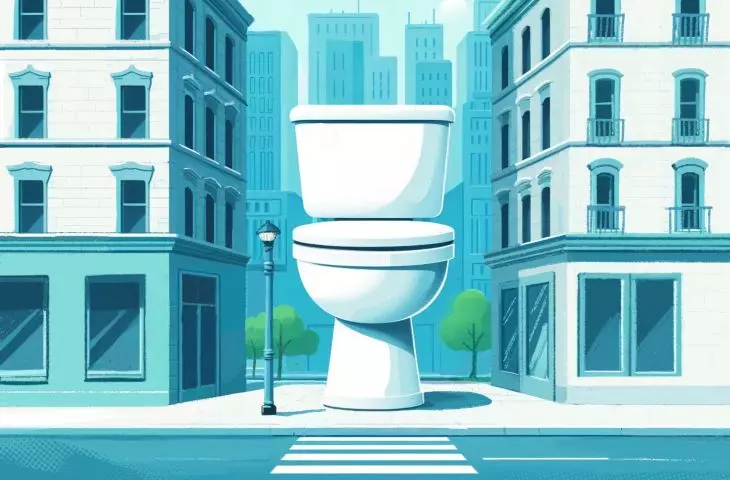Amsterdam is making a commitment to increase the number of public toilets, including those adapted for people with disabilities. This is an important step, given the push for an equal accessibility policy for toilets, known as potty parity.
In 2015, Geerte Piening was fined for urinating in public in Amsterdam when she could not find a public restroom nearby. The incident launched a nine-year battle for toilet equality in the Netherlands. Piening challenged the fine, arguing inequality in the number of public toilets for men and women. Her case sparked debate on the issue and prompted protests and political action.
The final settlement of the case represented a change - years of pressure from people fined for peeing in the street due to lack of facilities paid off with plans worth 4 million euros [1]. As a result, the city of Amsterdam has pledged to open more public toilets, including those accessible to people with disabilities. This is a significant change that has been fought for, especially bearing in mind the actions of other countries, such as the UK, where it is estimated that some 50% of public toilets have disappeared in the last 10 years. In 2005, there were fewer than 0.6,000 residents per public toilet in the UK. According to a 2019 report by Britain's Royal Society for Public Health titled "Taking the P***," one in five people say the lack of toilets in their neighborhood means they are cutting back on going out of their homes. Together with the abandonment of many toilets, a "urinary leash" has been re-created.
fighting for freedom through public toilets
The term, originally called Urination leash, has been described quite widely, but has further failed to break through into the mainstream, especially in Poland.The term, while sounding rather unusual, refers to a practice used to control such a common thing as the act of urination, and is strongly associated with gender. Historically, past society assumed that women took care of the home and did not need to be included in public needs - amenities were tailored to men. In the Victorian era, the lack of public facilities for women was intended to control their movements and keep them out of public spaces, "it was thought that women [...] were too modest to answer the call of nature when not in their homes," - says Dr. Clara Greed, a professor at the University of the West of England in Bristol[2]. She adds that there was a negative attitude toward the construction of toilets for women, because it was thought that women's use of public facilities was inappropriate. "This is why women simply stayed out of their homes for a long time," she says. The first women's toilets opened in London's West End in the 1880s.
equality in toilets
However, let's return to modern times, to the territory of Poland. According to data from the document "Sanitary State of the Country 2019," prepared by the Chief Sanitary Inspectorate, " an insufficient number of public toilets in relation to needs is observed, especially in holiday destinations, along tourist routes, markets, churches and near cemeteries." How many exactly? It's hard to say. There is no data on the overall state of public toilet availability. As the Supreme Audit Office reported in 2011, on average there were 11,900 people per permanently maintained public restroom (compared to less than 0,600 in the UK). The reason, according to the Chamber's report, was said to be the unreliable implementation by some municipalities of their own task, set forth in Article 3(2)(2)(d) of the Law on Cleanliness Maintenance, to ensure the construction, maintenance and operation of their own public toilets. 65.7% of the municipalities inspected at the time had spaces that were not adapted to the needs of people with disabilities, and 71.4% of the municipalities lacked information about the location of public toilets in public places, in municipal guides and on municipal websites.
One might say that after all, this is not a big problem, after all, public toilets are not trusted in our country anyway. The problem is that for many people, whether there is a toilet on the chosen route determines whether they leave home. For some, the problem of not having an accessible public toilet is so acute that they choose to consciously drain before going out, or they don't leave the house at all. In a way, this is a problem for all of us, as the elderly have the greatest problems with limited accessibility. Pregnant women are also among those in need, and they definitely need to use the toilet more often, as do children. In Australia, a toilet is a natural fixture in the playground. In our country, on the other hand, it is said that "every child has a bush" near the playground. Individual cities recognize the problem and are trying to meet the challenge of providing an adequate number of public toilets. For example, the digital map "Warsaw Today," operating until 2020, includes a map of toilets and information on their availability. Krakow, Poznan, Wroclaw and other large cities have a list of public toilets, including those adapted for people with disabilities, on their office websites. Apps are also being developed to indicate their presence. However, the lack of toilets continues to be complained about in tourist destinations and on trails.
one notch more
To the list of tasks should certainly be added not only the creation of more toilets, but also their smarter design, equal accessibility. This issue is contained in the English-language term Potty parity meaning equality regarding toilets. This is also what Geerte Piening, mentioned at the beginning, fought for.
Women spend more time in the bathroom than men. And while many jokes and fanciful stories have been made about why it's the girls who are always standing in lines, the reality boils down to a simple equation: physiology + culture + laws = long queue. Expanding on the topic, the first thing that should be singled out is the fact that urination in women takes longer due to the need to close the stall, the longer act of undressing and dressing, and the use of toilet paper. Physiologically, women are more likely to need to use the toilet because of a smaller bladder, menstruation, more frequent urinary tract infections than men, pregnancy pushing on the bladder or continence problems caused by childbirth[3]. What's more, they are more likely than men to wash their hands after using the toilet, also using soap more often[4].
View this post on Instagram
Additionally, women are often responsible for assisting children and the elderly or those with disabilities. It is most often in the women's restrooms that the changing table is located, and the restroom itself is marked as with adaptations for OzN. This also prolongs the wait for a bathroom. Some women use the restroom for breastfeeding, which also takes time and limits available space. Add to this the stipulation that "public restrooms should have at least one washbasin per 20 persons, at least one toilet bowl and one urinal per30 men and one toilet bowl per 20 women," then it's easy to count that for men there is one "mesh" per fifteen people, while for women there is one per twenty. Thus, needing more time to stay in the toilet, it is women who have less access to toilets. Access to toilets is not equitable, systemically it is even inefficient.
Suggestions for solving the problem of the lack of public toilets in Poland
The solution could, of course, be an amendment to the law, but a design decision seems much easier. Betting on a little more women's toilets, the availability of a changing table in both women's and men's toilets, or a separate bathroom for people with disabilities can create a much better and functional daily life. Also, the decisions of city councils, the resolution initiatives of citizens to create public toilets seem to make a difference. Recall here that a group of municipal residents with active electoral rights to the decision-making body can launch a citizen's resolution initiative[5], it must count:
1) in a municipality of up to 5,000 residents - at least 100 people;
2) in a municipality up to 20,000 residents - at least 200 people;
3) in a municipality with more than 20,000 residents - at least 300 people.
A draft resolution submitted as part of a citizen's resolution initiative becomes the subject of the municipal council's deliberations at the next session after the submission of the draft, but no later than after 3 months from the date of submission of the draft.
Magdalena Milert
[1] https://www.theguardian.com/world/2024/apr/29/urination-equality-amsterdam-women-win-fight-more-public-toilets
[2] https://www.bbc.com/news/world-41999792
[3] Plaskow, J. (2008). Embodiment, elimination, and the role of toilets in struggles for social justice. CrossCurrents, 58(1), 51-64.
[4] Borchgrevink, C. P., Cha, J., & Kim, S. (2013). Hand washing practices in a college town environment. Journal of environmental health, 75(8), 18-25.
[5] Article 41a. - [Citizen's legislative initiative] - Municipal self-government.
OJ 2024.609 t.j.














